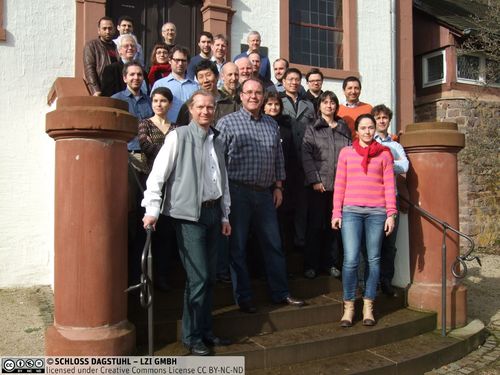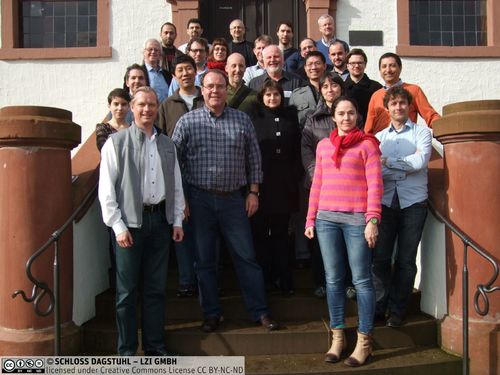Dagstuhl Seminar 14082
Visualization and Processing of Higher Order Descriptors for Multi-Valued Data
( Feb 16 – Feb 21, 2014 )
Permalink
Organizers
- Bernhard Burgeth (Universität des Saarlandes, DE)
- Ingrid Hotz (DLR - Braunschweig, DE)
- Anna Vilanova (TU Delft, NL)
- Carl-Fredrik Westin (Harvard Medical School - Boston, US)
Contact
- Andreas Dolzmann (for scientific matters)
- Susanne Bach-Bernhard (for administrative matters)
Dagstuhl Seminar Wiki
- Dagstuhl Seminar Wiki (Use personal credentials as created in DOOR to log in)
Higher-order descriptors, of which tensors are a special case, provide a natural language to describe phenomena in physics or image processing, e.g. medical imaging, fluid dynamics, or structural mechanics. The diversity of the application areas might explain why systematic and interdisciplinary investigations are still relatively rare. Many useful results are scattered throughout the scientific literature, and often researchers are only aware of articles in their own field, missing potentially valuable information in other areas. However, there are many shared challenges associated with this highly complex data, which can profit from a multidisciplinary approach. The idea of this Dagstuhl seminar is to bring together key researchers for disciplines ranging from visualization and image processing to applications in structural mechanics, fluid dynamics, and numerical mathematics. Thereby, the goal is to instigate solution-oriented research producing theoretical insight as well as practical algorithms applied to real-world problems. We will lay stress on the following issues:
Fundamental questions concerned with the processing of higher-order tensors dealing with
- Mathematical models to support a proper handling of higher-order tensors as elements of some adequate geometric space.
- The definition of useful decompositions, moving beyond spectral analysis.
- The investigation of high-level operations, e.g., generalization of mathematical morphology to higher-order descriptors.
- Interpolation, extrapolation and smoothing schemas that preserve important data characteristics.
- Statistics on higher-order descriptors to facilitate comparisons and parameter studies, e.g. to compare healthy and pathology groups.
- Sophisticated segmentation techniques for tensor fields:
- - Topological analysis of tensor fields.
- - Generalization of algorithms for scalar images to images using tensors or higher-order descriptors.
- Uncertainty analysis and visualization to generate reliable results. There is a large degree of uncertainty that accumulates throughout the processing pipeline. This concerns noise in the data acquisition process as well as parameter choices in multi-run simulations.
Analysis and visualization of higher order descriptors in applications
- Development of robust, scalable, and efficient algorithms and data structures capable to handle very large data sets.
- Development of visualization standards for diagnostic or analysis tools.
- Definition of intuitive visual abstractions carrying the most important tensor characteristics.
- Transfer of successful methods from one application to another.
- Development of standard use cases, e.g., to support the design process of construction pieces in structural mechanics.
- Definition of benchmarks and to foster the generation of data repositories.
This Dagstuhl seminar is the fifth in a series of stimulating, highly interdisciplinary Dagstuhl seminars. Previous seminars resulted in various collaborations and books that reflect the excitement and inspiration generated by these seminars. The charming atmosphere of Schloss Dagstuhl will prove once more to be a powerful catalyst that initiates vivid discussions, fruitful exchange of expertise, and lasting scientific relations between the participating researchers.
Higher Order Descriptors for Multi-Valued Data
This seminar is the 5th in a series of Dagstuhl Seminars devoted to the visualization and processing of higher-order descriptors, of which tensors are a special case. They provide a natural language to describe phenomena in physics or image processing, e.g. medical imaging, fluid dynamics, or structural mechanics. Due to the increasing complexity of data generated in the engineering industry and the rapid advances in medical imaging, multi-valued data have gained significant importance in scientific visualization and image processing. Compared to their importance analysis and processing tools are still relatively rare.
In many scientific and engineering applications, as modern product development processes, simulations are an essential part of the advancement of the field. The results are large and complex data sets often comprising multi-filed data of various kind. Thereby, the tensor concept is essential for the description of physical phenomena related to anisotropic behavior. Examples for second-order tensors are stress and strain fields, inertia tensors, and orientation distribution tensors. Higher-order tensors occur when multiple vector fields or second-order tensors are set into relation, e.g., the stiffness tensor relating stress and strain. The field of engineering faces many open problems in tensor field analysis and visualization.
In medical imaging, multi-valued data include diffusion-weighted magnetic resonance imaging (dMRI), a medical imaging modality that allows the measurement of water diffusion in tissue (e.g., white matter or muscle) in vivo. Simple models approximate the diffusion in fibrous tissue by a second-order diffusion tensor (i.e., a positive semi-definite 3 X 3 matrix). But, often the acquired data is more complex and cannot be sufficiently described by the second-order tensor model and requires higher-order descriptors (i.e., higher-order tensors or spherical harmonics).
Even though these applications are very different in their nature they face many shared challenges associated with this highly complex data, which can profit from a multidisciplinary approach. The idea of this Dagstuhl Seminar was to bring together key researchers for disciplines ranging from visualization and image processing to applications in structural mechanics, fluid dynamics, and numerical mathematics.
Seminar Topics and Breakout Sessions
The seminar has been organized in presentation and breakout sessions. The presentation sessions gave the participants the possibility to presented recent developments in the multidisciplinary field. The talks covered a broad variety of topics related to both theoretical and practical issues. They served as basis for inspiring discussions across the application areas, which demonstrated that there are many shared issues related to analyzing and visualizing fields of tensors and higher-order descriptors. Besides the presentations, we put an emphasis on breakout sessions, which were very successful already in the previous meeting. They were targeted at fostering focused discussions in smaller groups. During a first session the group defined some driving objectives that partially already emerged in preparatory discussions:
- Statistics on higher-order descriptors and visualization of uncertainty
- Generalization of mathematical framework to higher-order descriptors
- Features on tensor visualization
- Next generation diffusion MRI
Most issues identified in the call have been discussed. Subjects that found special attention can be summarized as: Fundamental general topics, as tensor interpolation, statistics, morphology, and topology; Questions related to pattern description and detection; More specific issues like the analysis of ensembles, the visualization and measurement of differences and anomalies for engineering as well as for medical data sets. Further, there has been much interest in double pulse field gradient methods that have been discussed as possible next generation diffusion MRI. The outcome of the sessions can also be seen at http://www.dagstuhl.de/wiki/index.php/14082#Breakout_topics
The breakout sessions again turned out to be very successful. The format of the breakout sessions fits very well in the Dagstuhl environment promoting discussions and interactions. We could also observe that, for some topics, it is not easy to go beyond a list of challenges in such a short time frame. This motivates to strengthen these sessions by pre-defining topics in preparation of the meeting and asking selected participants for related statements.
Outcomes
The participants all agreed that the meeting was successful and stimulating. Seminar participants are already collaborating on a Springer book summarizing the results of the meeting. The Springer book will have about seventeen chapters authored by the meeting participants. It is also planned to summarize the results of two breakout sessions as a chapter of the book. The participants Thomas Schultz and Ingrid Hotz agreed on taking the lead for the collection of the contributions and the assembly of the book. We expect the book to be published in 2015.
It was voted that the group will apply for another meeting in this series, and that in addition to the current organizer (Ingrid Hotz) there will be two new organizers (Thomas Schultz, University Bonn Germany and Evren Özarslan, Harvard Medical School -- Boston, US) for the next event.
Aknowledgement
The organizers thank all the attendees for their contributions and extend special thanks to the team of Schloss Dagstuhl for helping to make this seminar a success. As always, we enjoyed the warm atmosphere of the Schloss, which supports both formal presentations as well as informal exchanges of ideas.
 Bernhard Burgeth, Ingrid Hotz, Anna Vilanova, and Carl-Fredrik Westin
Bernhard Burgeth, Ingrid Hotz, Anna Vilanova, and Carl-Fredrik Westin
- Bernhard Burgeth (Universität des Saarlandes, DE) [dblp]
- Guoning Chen (University of Houston, US) [dblp]
- Tom Dela Haije (TU Eindhoven, NL) [dblp]
- Cagatay Demiralp (Stanford University, US) [dblp]
- Luc Florack (TU Eindhoven, NL) [dblp]
- Andrea Fuster (TU Eindhoven, NL) [dblp]
- Christoph Garth (TU Kaiserslautern, DE) [dblp]
- Hans Hagen (TU Kaiserslautern, DE) [dblp]
- Ingrid Hotz (DLR - Braunschweig, DE) [dblp]
- Hans Knutsson (Linköping University Hospital, SE) [dblp]
- Max Langbein (TU Kaiserslautern, DE) [dblp]
- Georgeta Elisabeta Marai (University of Pittsburgh, US) [dblp]
- Rodrigo Moreno (Linköping University Hospital, SE) [dblp]
- Lauren O'Donnell (Harvard Medical School - Boston, US) [dblp]
- Evren Özarslan (Bogaziçi University - Istanbul, TR) [dblp]
- Renato Pajarola (Universität Zürich, CH) [dblp]
- Ofer Pasternak (Harvard Medical School - Boston, US) [dblp]
- Jos B.T.M. Roerdink (University of Groningen, NL) [dblp]
- Gerik Scheuermann (Universität Leipzig, DE) [dblp]
- Marc Schöneich (Universität des Saarlandes, DE) [dblp]
- Thomas Schultz (Universität Bonn, DE) [dblp]
- Nir Sochen (Tel Aviv University, IL) [dblp]
- Markus Stommel (Universität des Saarlandes, DE) [dblp]
- Anna Vilanova (TU Delft, NL) [dblp]
- Carl-Fredrik Westin (Harvard Medical School - Boston, US) [dblp]
- Eugene Zhang (Oregon State University, US) [dblp]
Related Seminars
- Dagstuhl Perspectives Workshop 04172: Visualization and Image Processing of Tensor Fields (2004-04-18 - 2004-04-23) (Details)
- Dagstuhl Seminar 07022: Visualization and Processing of Tensor Fields (2007-01-09 - 2007-01-13) (Details)
- Dagstuhl Seminar 09302: New Developments in the Visualization and Processing of Tensor Fields (2009-07-19 - 2009-07-24) (Details)
- Dagstuhl Seminar 11501: Visualization and Processing of Tensors and Higher Order Descriptors for Multi-Valued Data (2011-12-11 - 2011-12-16) (Details)
- Dagstuhl Seminar 16142: Multidisciplinary Approaches to Multivalued Data: Modeling, Visualization, Analysis (2016-04-03 - 2016-04-08) (Details)
- Dagstuhl Seminar 18442: Visualization and Processing of Anisotropy in Imaging, Geometry, and Astronomy (2018-10-28 - 2018-11-02) (Details)
Classification
- bioinformatics
- computer graphics / computer vision
Keywords
- visualization
- image processing
- tensor fields
- diffusion tensor imaging
- high angular resolution diffusion imaging (HARDI)
- data analysis
- feature extraction
- fiber tracking
- structural mechanics
- fluid dynamics



 Creative Commons BY 3.0 Unported license
Creative Commons BY 3.0 Unported license
